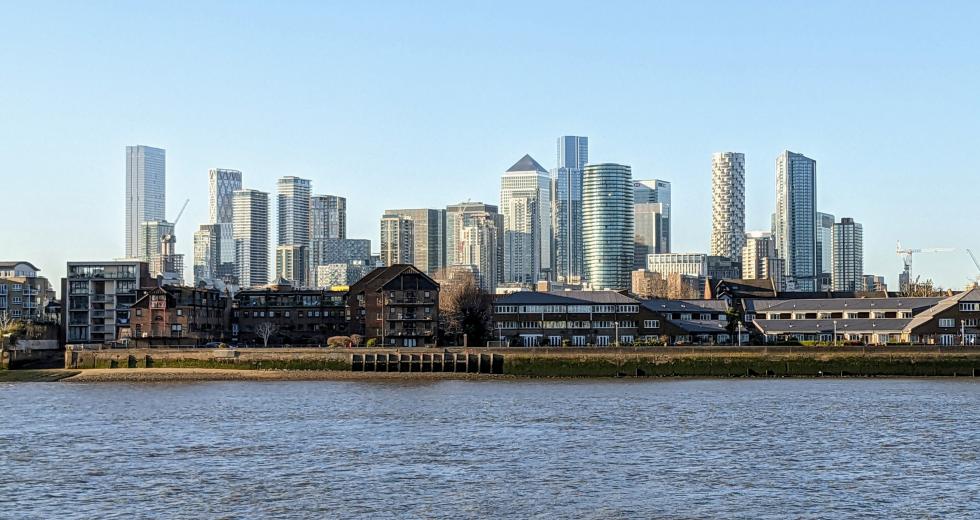
Before the redevelopment of Canary Wharf—before all the bright lights, tall buildings and expensive property—it was one of the busiest docks in the world. The Canary Wharf estate was owned by the West India Dock Company in its Victorian and Edwardian heyday. The Port of London was established as an authority in 1909 and took over control of this gateway to the East End’s Thames peninsula, the Isle of Dogs, from the West India Dock Company, largely to accept fruit from the Mediterranean and the Canary Islands. Due to this trade, one prominent quay and its abutting warehouse were named Canary Wharf.
When cargo transport was containerised in the 1960s, the port industry declined, and the docks were closed in 1980 when the UK Government proposed redevelopment of the area. This led to the setting-up of the London Docklands Development Corporation in 1981 and the granting of ‘Urban Enterprise Zone’ status to the Isle of Dogs in 1982.
Today, Canary Wharf has been transformed into an area of tall buildings and plays home to many of the City of London’s banks and financial institutions that have overspilled eastwards into the Borough of Tower Hamlets. With its own driverless urban rail line, the Docklands Light Railway, and a local airport (City of London) both opening in 1987, the area immediately became much easier to access just as the stock market was booming. However, by the time the Wharf eventually opened for business in 1991, the commercial market had collapsed and Olympia and York Canary Wharf Ltd filed for bankruptcy.
Worried that Canary Wharf would end up posing direct competition to the Square Mile, banking interests obtained a change in urban planning at the Corporation of the City of London to expand the supply of new office blocks in the City itself. This brought about the collapse and failure of the Canary Wharf project as conceived of in the Thatcher era.
In 1999, an international consortium, Canary Wharf Group, took control of the land for US$1.2 billion and Paul Reichmann was appointed Chairman. The Group was taken over in 2004 by Glick Family Investments, a concern partnering with Morgan Stanley, by backing the tellingly-named Songbird Estates PLC to make the purchase.
The site now contains around 16 million square feet of office and retail space, of which nearly half is owned by Canary Wharf Group. Many major banks, media organisations, agencies and world and European headquarters are housed in it. The European Medicines Agency used to be located here; however, after the UK left the EU, it moved to Amsterdam, only to be replaced on site by Britain’s very own medicine and healthcare products regulator, the MHRA.
Residents confess that there is not much socialising to be had at Canary Wharf. There is a shopping mall and a couple of cinemas surrounded by leafy trees, but there is little in the way of community spirit, although accessibility to central London is facilitated by many of the recent bolt-ons to the London Underground network, including the Jubilee Line, the Docklands Light Railway and the brand-new Elizabeth Line. Currently, there are 2,300 apartments on site, with another 2,300 currently under construction. The promise is that there is a property for every income level and that this will enable researchers and scientists to live nearby. Canary Wharf is nowadays described as a city within a city.
Today, we can see the evolution of a new community in Canary Wharf: that of the largest wet lab (laboratory accredited for hazardous substances) in Europe. The Canary Wharf Group and Kadans Science Partner have announced a joint venture to develop a 750,000 sq. ft hub, focusing on the UK Government’s darling among industries: Life Sciences.
As of yet, no financial value has been put on this venture; however, it is thought to be in the region of £500 million. The new building will house groundbreaking, state-of-the-art laboratory and innovation space for the Life Sciences sector. Based on North Quay—conveniently next to the Canary Wharf station on the Elizabeth Line—it is to be 22 storeys in height. It is said that KPF, a New York company, will design the building, which is due to be completed in 2026.
Kadans’ business partner and sponsor is AXA IM Alts: a Dutch-headquartered company, an investment manager with a corporate background in French insurance, and a European leader in the development and management of Life Sciences buildings and ‘ecosystems’.
The global Life Sciences industry is growing by the day and it appears to be the designated means for Britain to expand to become the global Life Science superpower, a clear aim of the UK Government. In essence, our lives becomes their science, and the British population becomes a valuable scientific commodity.
But at what cost, and on what grounds? It appears HM Government has sold us to the world as experimental lab rats for the rest of the planet. A very valuable commodity indeed, and one whose safety they will claim to be overseen by the MHRA—the same agency whose Yellow Card alert system failed to alert millions of members of the public to the dangers of Covid–19 vaccination damage.

